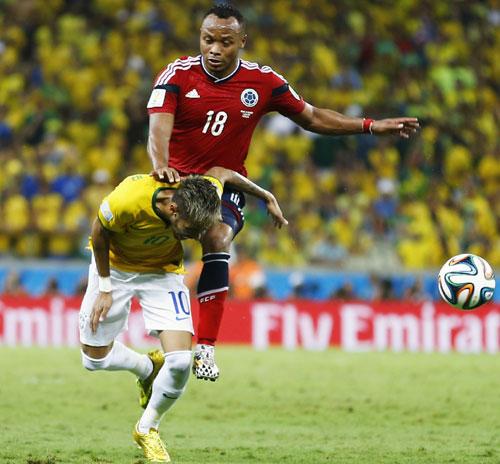Photographs: Marcelo Del Pozo/Reuters Garima Anandani
Spinal cord injuries are often the result of unpredictable accidents and/or violent events.
Garima Anandani, chief spine specialist at Qi Spine lists five incidents that can put you in Neymar's place and advises on basic steps to follow if ever such a situation visits anybody before expert medical help arrives.
The injury that Brazilian soccer star Neymar Jr suffered to his spine could happen to you as well.
Brazil's star-striker and top goal scorer, Neymar Jr, is out of the World Cup with a cracked vertebra and won't be playing the crucial semi-final match against Germany, July 9.
Neymar suffered a transverse fracture of the left side of the third lumbar vertebra after Colombian defender Camilo Juan Zuniga challenged him during Brazil's 2-1 victory over Colombia last Friday.
The spine is an engineering marvel and injury to the spine is serious business. Spinal cord injuries are often the result of unpredictable accidents and/or violent events.
But other than a harsh challenge by an opponent's ruthless knee, what are the things that could injure your vertebra?
Here's a list compiled by Dr Garima Anandani:
1. Diving into water that is too shallow and hitting the bottom
2. Trauma during a car accident (specifically trauma to the face, head and neck region, back, or chest area)
3. Falling from a significant height
4. Electrical accidents resulting in extreme shocks.
5. Severe twisting of the middle portion of the torso, something that could possibly happen in Mumbai's trains during rush hour.
How to handle such a situation?
1. Do not move the person or disturb him or her in any way unless it is absolutely necessary. This includes repositioning the person's head or attempting to remove a helmet.
2. Encourage the person to stay as still as possible, even if they feel they are capable of getting up and walking on their own.
3. Insist on a complete neurological exam. This will help doctors determine whether the spinal cord was indeed injured and, if so, where.
CT scans, MRIs, X-rays of the spine, and evoked potential testing (which measures how quickly nerve signals reach the brain) can help diagnose a situation better. If needed, recommend a spine function test.
Garima Anandani has a Diploma in Mechanical Diagnosis and Therapy from the McKenzie Institute International and University of Otago (Dip M.D.T.); Specialised training in spine rehabilitation from St David's Spine and Sports Therapy, Austin, Texas (USA) and from The Polyclinic, Seattle (USA); Certified Mulligan Practitioner (C.M.P.); postgraduate Diploma in Rehabilitation (D.R.P.T)


Comment
article